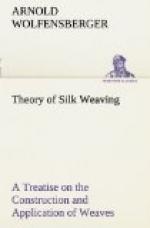[Page 100] JACQUARD WEAVES
Jacquard weaves usually show on a plain ground figure or flower effects. To obtain these effects the ground is made of one weave, say taffeta, while the figures or flowers are produced in another weave, say satin.
We enter the warp through a jacquard harness, and according to the repeat use a 200, 400, 600, 900, 1200, etc., hook jacquard machine, which means 200, 400, 600, 900 and 1200 ends per repeat.
With a 600-hook machine a larger repeat can be produced than with a 499-hook machine. For instance, if we want to make a cloth the figures of which are to be two inches apart, it is a two-inch repeat, and use the count of 50/4 or 200 ends per inch, we can use a 400-hook machine, 2 in. x 200 ends. But we can make this cloth also on a 1200-hook machine, only the repeat must be designed three times. The advantage of using a 1200-hook machine with the count 50/4 is that 2, 3, 4, 6-inch repeats can be produced, while with a 400-hook machine, only a 2-inch repeat can be made.
There is no end to all the different weaves and the possible flower and other pattern effects that can be made with the jacquard machine. For a jacquard weaving plant the designing is the most important factor.
* * * * *
BOX LOOM WEAVES INCLUDING CREPES
Box looms are required for weaves such as bayaderes, checks, plaids (see pages 63-65), bengalines, crepes, etc., where two or more shuttles are needed to bring out the effect.
For the crepes (crepe de chine, crepe georgette) only two shuttles are needed, while plaids and other articles are made with more shuttles.
To weave such articles the loom or the lay must be fitted with two or more shuttle boxes on one or both sides of the loom.
[Page 101] If a manufacturer decides to change plain looms to box looms or buy new box looms, it is wise to get 4 x 4 boxes, or four shuttle boxes on each side.
With these looms about everything can be made that is called for in box-loom effects, and as styles change, it is wise to be prepared.
* * * * *
MANUFACTURING COSTS
The calculator first ascertains for the warp: What silk will be used, the cost of the same, total number of ends in the warps for the amount of silk, cost of throwing, dyeing, winding, warping, twisting, entering, and weaving.
Then the filling: Silk to be used, how much, cost of silk, cost of throwing, dyeing, winding, doubling, quilling.
After this determine the cost of weaving, cloth picking, finishing, factory costs, and selling expenses.
To-day most of the operations are paid by “piece work.”
The calculator must always take into consideration that poor raw silk or poor dyeing make production slow, increase the cost of labor, and also that more waste will be made.




